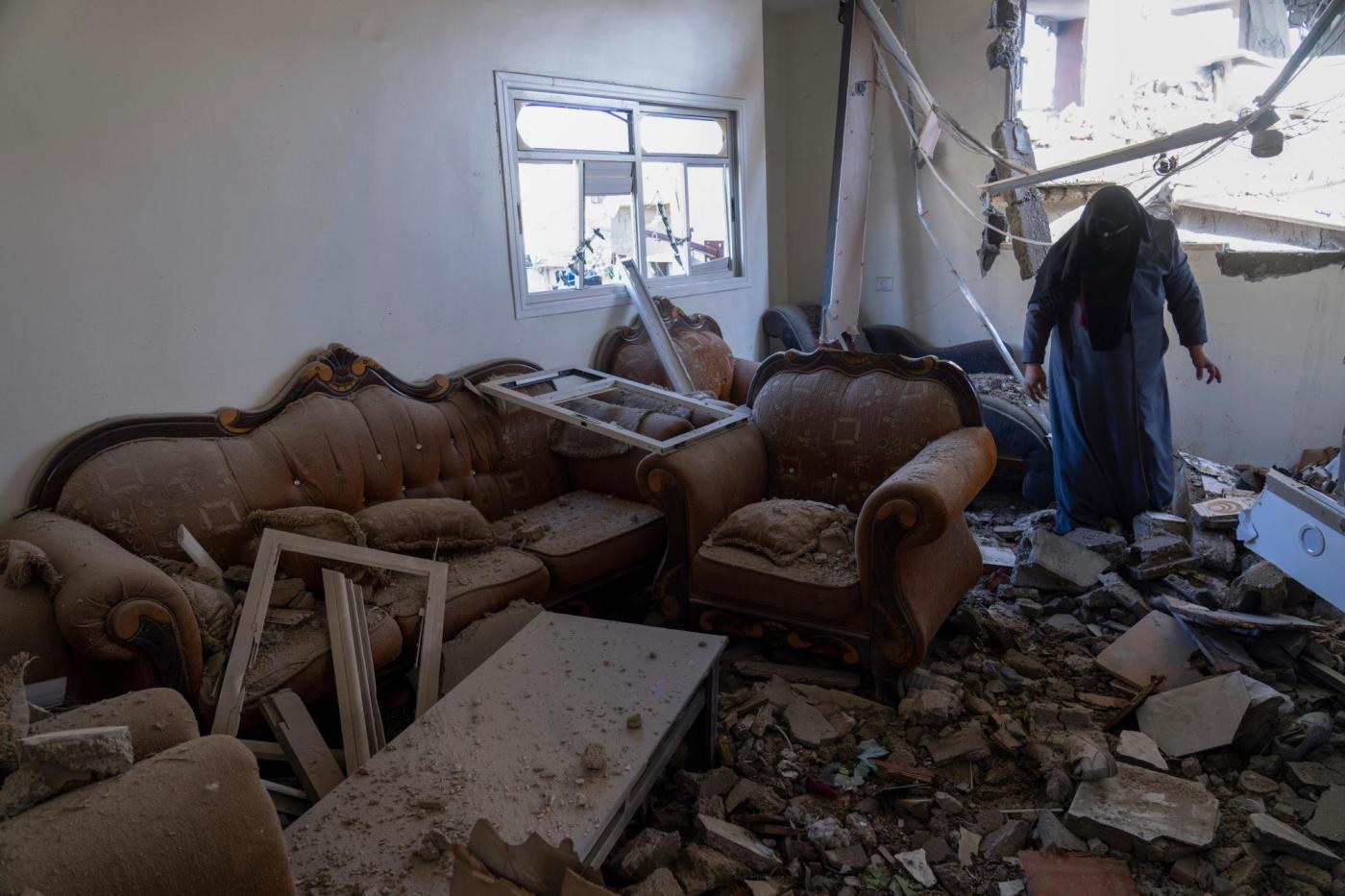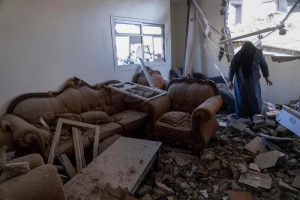
Israel orders evacuations as it widens offensive but Palestinians are running out of places to go
By WAFAA SHURAFA, SAMY MAGDY and JACK JEFFERY (Associated Press)
DEIR AL-BALAH, Gaza Strip (AP) — Israel renewed calls Monday for mass evacuations from the southern town of Khan Younis, where tens of thousands of displaced Palestinians have sought refuge in recent weeks, as the military widened its ground offensive and bombarded targets across the Gaza Strip.
The expanded assault posed a deadly choice for hundreds of thousands of Palestinians — either stay in the path of Israeli forces or flee to squeeze into progressively tinier slivers of the Gaza Strip, with no guarantee of safety. Aid workers warned that the mass movement would worsen the already dire humanitarian catastrophe in the territory.
“Another wave of displacement is underway, and the humanitarian situation worsens by the hour,” the Gaza chief of the U.N. agency for Palestinian refugees, Thomas White, said in a post on X.
Israel has vowed to eliminate Gaza’s Hamas rulers, whose Oct. 7 attack into Israel triggered the deadliest Israeli-Palestinian violence in decades. The war has already killed thousands of Palestinians and displaced over three-fourths of the territory’s population of 2.3 million people. Hamas has been designated as a terrorist organization by the United States, Canada and the European Union.
Already under mounting pressure from its top ally, the United States, Israel appears to be racing to strike a death blow against Hamas — if that’s possible, given the group’s deep roots in Palestinian society — before any new cease-fire. But the mounting toll, which Palestinian health officials say has killed several hundred civilians since a weeklong truce ended Friday, is likely to further increase international pressure to return to the negotiating table.
It could also render even larger parts of the isolated territory uninhabitable.
Airstrikes and the ground offensive have transformed much of the north, including large areas in Gaza City, into a rubble-filled wasteland.
Hundreds of thousands of residents fled south during the assault. Now around 2 million people — most of the territory’s population — are crowded into the 230 square kilometers (90 square miles) that make up south and central Gaza, where Israel’s ground offensive is expanding. Their only escape is to other parts of that area, as both Israel and neighboring Egypt have refused to accept any refugees.
FIGHTING IN CENTRAL GAZA
Residents said Monday they heard airstrikes and explosions in and around Khan Younis overnight after the military dropped leaflets warning people to relocate farther south toward the border with Egypt.
The U.N. said Israel has ordered an area constituting about a fifth of Khan Younis to evacuate, an area that was home to some 117,000 people before the war and now hosts tens of thousands displaced from elsewhere. It said 21 shelters housing 50,000 people — the vast majority from northern Gaza — were in the evacuation zone. Large areas east of Khan Younis were also ordered to flee.
The military warned civilians Monday to avoid the main north-south highway between Khan Younis and the central town of Deir al-Balah, saying the road had become a “battlefield.” That indicated Israeli troops were approaching Khan Younis from the northeast, possibly with plans to cut central Gaza off from the south.
Al Jazeera television aired footage of medics rescuing people wounded by what appeared to have been a strike on a car on that stretch of highway. An Israeli tank could be seen just up the road.
Rear Adm. Daniel Hagari, the Israeli military spokesman, said the army is pursuing Hamas with “maximum force” in the north and south while trying to minimize harm to civilians.
He pointed to a map that divides southern Gaza into dozens of blocks in order to give “precise instructions” to residents on where to evacuate.
Some Palestinians have ignored past evacuation orders, saying they do not feel any safer in the areas where they are told to seek refuge — which have also been repeatedly bombed. Many also fear they will never be allowed back to their homes. The military has barred those who fled the north from returning, even during the cease-fire.
“The level of human suffering is intolerable,” Mirjana Spoljaric, the president of the International Committee of the Red Cross, said during a rare visit to Gaza. She also called for the immediate release of scores of hostages captured by Palestinian terrorists during the Oct. 7 attack.
“It is unacceptable that civilians have no safe place to go in Gaza, and with a military siege in place there is also no adequate humanitarian response currently possible.”
RISING TOLL
The Health Ministry in Hamas-run Gaza said the death toll in the territory since Oct. 7 has surpassed 15,890 people – 70% of them women and children — with more than 42,000 wounded. The ministry does not differentiate between civilian and combatant deaths.
Health Ministry spokesman Ashraf al-Qidra said hundreds have been killed or wounded since the cease-fire’s end early Friday, with many still trapped under rubble.
The Al-Aqsa Martyrs Hospital in Deir al-Balah received 32 bodies overnight after Israeli strikes across central Gaza, said Omar al-Darawi, an administrative employee. Associated Press footage showed women in tears, kneeling over the bodies of loved ones and kissing them.
The military said aircraft struck some 200 Hamas targets overnight, with ground troops operating “in parallel,” without elaborating. It said troops in northern Gaza uncovered a militant hideout in a school after coming under attack. Inside, they found two tunnel shafts, one of which had been booby-trapped, as well as explosives and weapons, the military said.
It is not possible to independently confirm battlefield reports from either side.
Israel says it targets Hamas operatives, not civilians, and blames civilian casualties on Hamas, accusing them of operating in residential neighborhoods. Still, it does not provide accounting for its targets in individual strikes.
In addition to leaflets dropped over Gaza, the military has used phone calls and radio and TV broadcasts to urge people to leave specific areas.
Israel claims to have killed thousands of militants, without providing evidence. Israel says at least 81 of its soldiers have been killed.
U.S. PRESSURE
The U.S. is pressing Israel to avoid more mass displacements and civilian deaths, a message underscored by Vice President Kamala Harris during a visit to the region. She also said the U.S. would not allow the forced relocation of Palestinians out of Gaza or the occupied West Bank, or the redrawing of Gaza’s borders.
But it’s unclear how far the Biden administration is willing or able to go in pressing Israel to rein in the offensive, even as the White House faces growing pressure from its allies in Congress.
The U.S. has pledged unwavering support to Israel since the Oct. 7 attack, which killed over 1,200 people, mostly civilians, including rushing munitions and other aid to Israel.
Israel has rejected U.S. suggestions that control over postwar Gaza be handed over to the internationally recognized Palestinian Authority as part of a renewed effort to resolve the overall conflict by establishing a Palestinian state.
Hopes for another temporary truce faded after Israel called its negotiators home over the weekend. Hamas said talks on releasing any more of the scores of hostages seized on Oct. 7 must be tied to a permanent cease-fire.
The earlier truce facilitated the release of 105 of the roughly 240 Israeli and foreign hostages taken to Gaza during the Oct. 7 attack, and the release of 240 Palestinians imprisoned by Israel. Most of those released by both sides were women and children.
___
Magdy and Jeffery reported from Cairo.
Full AP coverage at https://apnews.com/hub/israel-hamas-war


